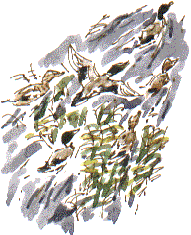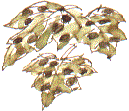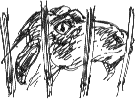Nature Diary Rocks History Gallery Links Home Page  THE RIVER is beginning to ebb a little and the taller plants that grew on the silty island are showing above water again. Five Mallard drakes and four ducks are dabbling there. When I stop to watch from the bridge they become uneasy and set off upstream.
THE RIVER is beginning to ebb a little and the taller plants that grew on the silty island are showing above water again. Five Mallard drakes and four ducks are dabbling there. When I stop to watch from the bridge they become uneasy and set off upstream.
Leaf-miners  Plants have a hard time of it altogether. A Smooth Sow-thistle by the towpath is still in flower. Most of its leaves have leaf-mines on them. The larvae of a fly, Phytomyza atricornis, makes tunnels like this. Other flies and micro-moths make similar leaf-mines. You can see that the tunnel grows wider as the larva progresses. Some of them follow the edge of the leaf. In other leaves two have been at work, turning the surface into a road map. There appears to be an escape hole at the end of one of the tunnels. Did the adult insect emerge, or did a bird peck it out? All the requirements for the larva's development are there inside the leaf. It is surrounded by its food, protected by a waxy cuticle above and, below, there are the stomata, for ventelation.
Plants have a hard time of it altogether. A Smooth Sow-thistle by the towpath is still in flower. Most of its leaves have leaf-mines on them. The larvae of a fly, Phytomyza atricornis, makes tunnels like this. Other flies and micro-moths make similar leaf-mines. You can see that the tunnel grows wider as the larva progresses. Some of them follow the edge of the leaf. In other leaves two have been at work, turning the surface into a road map. There appears to be an escape hole at the end of one of the tunnels. Did the adult insect emerge, or did a bird peck it out? All the requirements for the larva's development are there inside the leaf. It is surrounded by its food, protected by a waxy cuticle above and, below, there are the stomata, for ventelation.
Tar Spot  A Garden Spider the size of a pea has spun a large orb web on the branches of a Sycamore overhanging a stream. All the leaves of the sycamore are spotted with black, thumbprint size blotches. There's a lot of this Tar Spot fungus, Rhytisma, around this year. Clean air may have helped it to spread. When the clean air acts of the 1960s reduced the amount of coal smoke, Black spot, Diplocarpon rosae, on Roses, became more of a problem in cities. Sulphur in the atmosphere and in rain had acted as a fungicide.
A Garden Spider the size of a pea has spun a large orb web on the branches of a Sycamore overhanging a stream. All the leaves of the sycamore are spotted with black, thumbprint size blotches. There's a lot of this Tar Spot fungus, Rhytisma, around this year. Clean air may have helped it to spread. When the clean air acts of the 1960s reduced the amount of coal smoke, Black spot, Diplocarpon rosae, on Roses, became more of a problem in cities. Sulphur in the atmosphere and in rain had acted as a fungicide.
|

 Two young flowering cherries, planted six years ago when the bridge was rebuilt, have, I'm afraid, seen their last season. They've recently had their bark stripped, right around the trunk, at browse height. It could, I expect, be a squirrel, but this is more likely to be the work of the goat that has been grazing here.
Two young flowering cherries, planted six years ago when the bridge was rebuilt, have, I'm afraid, seen their last season. They've recently had their bark stripped, right around the trunk, at browse height. It could, I expect, be a squirrel, but this is more likely to be the work of the goat that has been grazing here. On the causey path a Ground Beetle staggers about, pulling and pushing to remove another beetle that has been squashed.
On the causey path a Ground Beetle staggers about, pulling and pushing to remove another beetle that has been squashed.